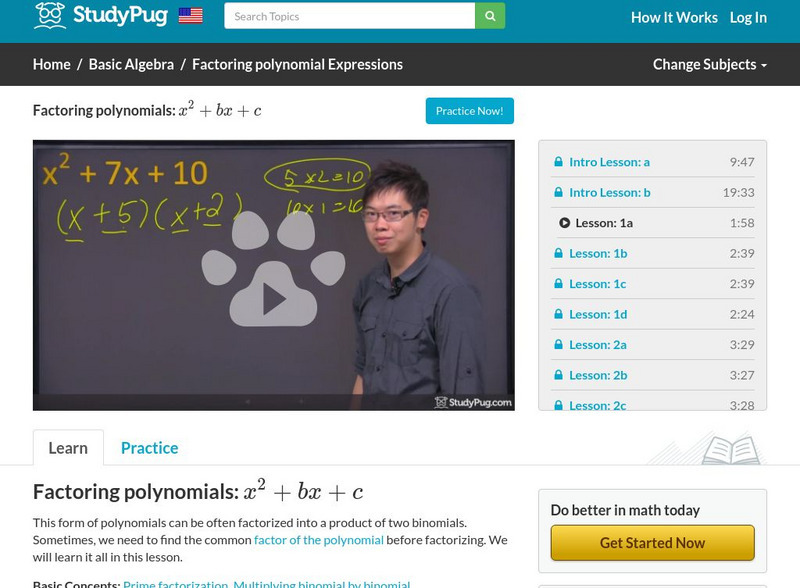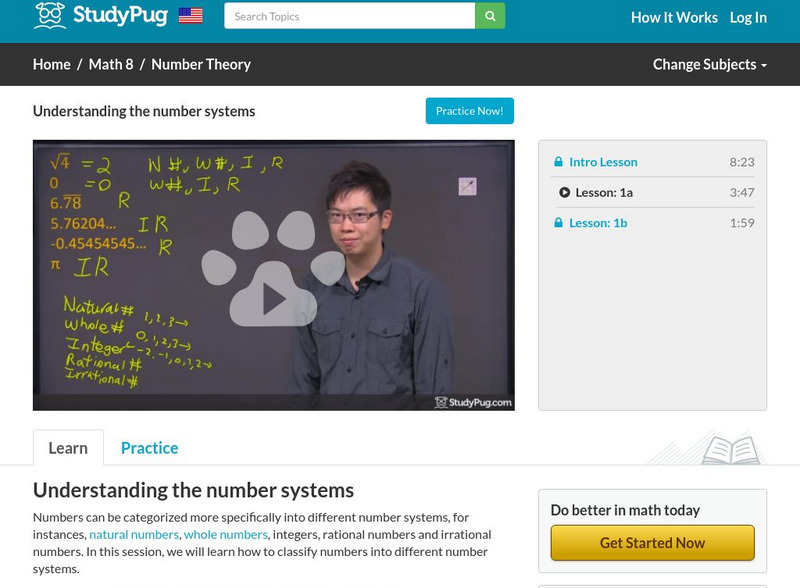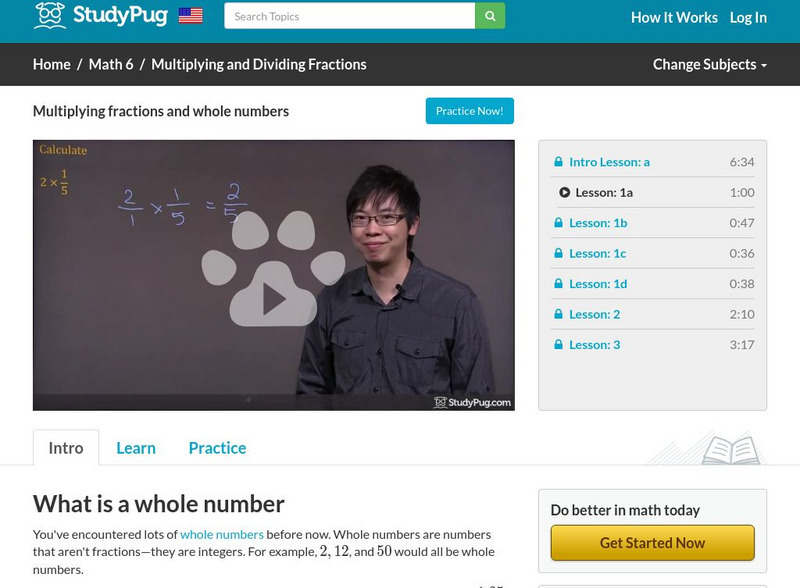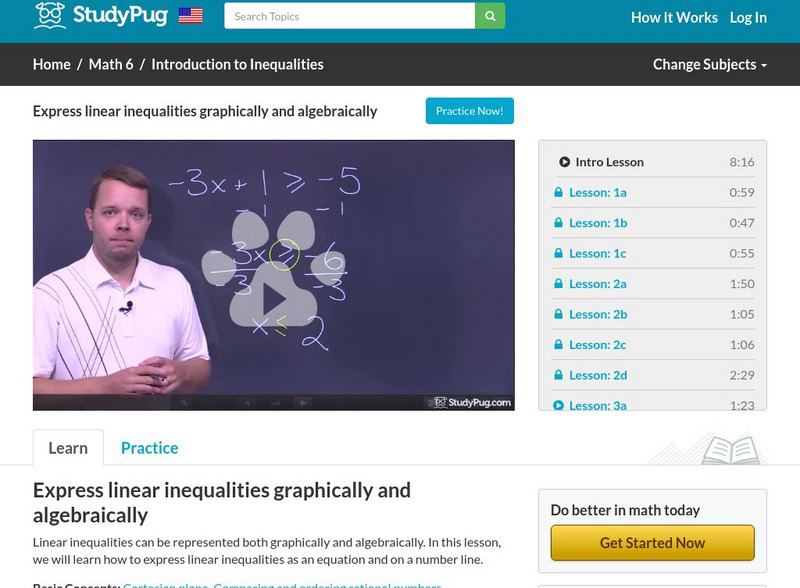Hi, what do you want to do?
Study Pug
Study Pug: Metric Systems
In this tutorial, you will see how to convert cm to m (centimeter to meter) and m to km (meter to kilometer). Thorough descriptions and examples are provided. Also includes a video lesson and practice problems. [2:06]
Study Pug
Study Pug: Advantages and Disadvantages of Different Graphs
This lesson discusses the advantages and disadvantages of using different types of graphs to display data, such as pictographs, line graphs, and bar graphs. [3:08]
Study Pug
Study Pug: Introduction to Imaginary Numbers
Video tutorial introduces the notion of imaginary numbers, and how to simplify them. [10:19]
Study Pug
Study Pug: Inverse Functions
View this video tutorial to learn about inverse functions, a function that reverses all the operations of another function. [12:05]
Study Pug
Study Pug: Representing Percents
Video lesson uses grids and diagrams to help explain the concept of percents. [5:01]
Study Pug
Study Pug: Ratios
Watch this video lesson to learn how to write ratios in the lowest terms as well as in fraction and percent form. [1:09]
Study Pug
Study Pug: Line Symmetry
Video lesson demonstrates how to find and draw lines of symmetry for figures. [0:57]
Study Pug
Study Pug: What Is a Rational Function?
Detailed video lesson explores rational functions. [42:37]
Study Pug
Study Pug: Factoring Polynomials X2+bx+c
This video lesson illustrates how to find the common factor of the polynomial before factorizing. [1:16]
Study Pug
Study Pug: Least Common Multiple (Lcm)
Video tutorial uses the "cake method" to find the least common multiple.[1:24]
Study Pug
Study Pug: Distance Formula
Watch this video to learn how to use the distance formula to calculate the distance between two points on a graph when you know the coordinates of both points. [1:45]
Study Pug
Study Pug: Parallel Line Equation
This video lesson takes a look at questions related to parallel line equations. [2:03]
Study Pug
Study Pug: Understanding the Number Systems
Numbers can be categorized more specifically into different number systems, for instances, natural numbers, whole numbers, integers, rational numbers, and irrational numbers. In this video, you will learn how to classify numbers into...
Study Pug
Study Pug: Introduction to Surface Area of 3 Dimensional Shapes
3-dimensional shapes have many surfaces, and they do not necessarily look the same from different angles. This tutorial contains a video demonstration and practice problems to help you understand and see the surface area of 3-dimensional...
Study Pug
Study Pug: Model and Solve One Step Linear Equations
Linear equations which can be solved with a single operation are called one-step linear equations. In this video, you will see how to solve one-step linear equations represented in diagrams and in equation form. [2:15]
Study Pug
Study Pug: Multiplying Fractions and Whole Numbers
This video walks you through the four main steps when multiplying fractions with whole numbers. Includes explanations, examples and practice problems. [1:00]
Study Pug
Study Pug: Using Exponents to Describe Numbers
When you multiply the same number two times or more, you may express it in exponential form. A number in exponential form has two components, the base and the exponent. This video shows examples of the relationship between repeated...
Study Pug
Study Pug: Determining Probabilities Using Tree Diagrams and Tables
Tables and tree diagrams are useful tools to calculate probabilities. With them, you can list all the possible outcomes of an event in a clear and easy to understand way. Watch this video with an easy to understand example. [1:03]
Study Pug
Study Pug: Solving Multi Step Linear Inequalities
You will learn how to solve multi-step linear inequalities in this lesson. Besides typical math questions, you are going to see word problems related to multi-step linear inequalities and money. [8:15]
Study Pug
Study Pug: Solving One Step Linear Inequalities
You will learn how to solve one-step linear inequalities in this video. Besides typical math questions, you are going to see word problems related to one-step linear inequalities and money. [8:15]
Study Pug
Study Pug: Express Linear Inequalities Graphically and Algebraically
Linear inequalities can be represented both graphically and algebraically. In this video, you will learn how to express linear inequalities as an equation and on a number line. [8:15]
Study Pug
Study Pug: Adding and Subtracting Rational Expressions
When adding and subtracting rational expressions, the denominators of the expressions will dictate how we solve the questions. Learn more about subtracting rational expressions from this video, which includes detailed explanations and...
Study Pug
Study Pug: Absolute Value Functions
Absolute value is basically the distance between "number" and "zero" on a number line. You will learn more about this concept in this video. You will also learn how to express absolute value functions as piecewise functions. [10:47]
Study Pug
Study Pug: Squares and Square Roots
This video focuses on finding the square of a whole number and the square root of a perfect square. In order to do this, you will first learn how to do prime factorization, a method to find the prime factors of a number. [1:58]




























